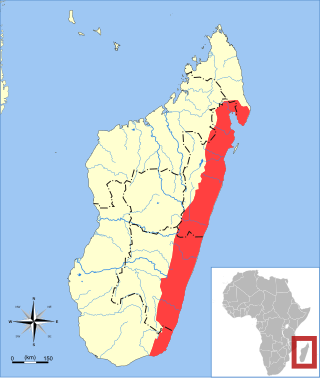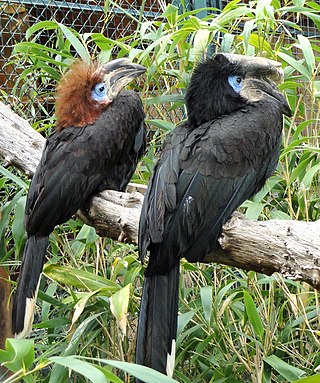
The black rosy finch or black rosy-finch is a species of passerine bird in the family Fringillidae native to alpine areas above treeline, of the western United States. It is the most range-restricted member of its genus, and a popular photography subject for birdwatchers.

Ninia atrata, known commonly as Hallowell's coffee snake, Hallowell's earth snake, the red-nape snake, and the South American coffee snake, is a species of small terrestrial snake in the family Colubridae. The species is native to southern Central America and northern South America.

Gobiopsis atrata, the New Zealand black goby, is a species of goby endemic to the marine waters around northern New Zealand where it occurs in tide pools and on reefs down to depths of about 30 metres (98 ft). It lives in narrow crevices and is most commonly seen with its head poking out of its lair to which it will hastily retreat if disturbed. This species can reach a length of 8.5 centimetres (3.3 in) TL.

Xestia is a genus of noctuid moths. They are the type genus of the tribe Xestiini in subfamily Noctuinae, though some authors merge this tribe with the Noctuini. Species in this genus are commonly known as "clays", "darts" or "rustics", but such names are commonplace among Noctuidae. Xestia moths have a wide distribution, though they most prominently occur in the Holarctic.

Peters's sheath-tailed bat is a species of sac-winged bat in the family Emballonuridae. It is found only in Madagascar.

The black-casqued hornbill, or black-casqued wattled hornbill, is a species of hornbill in the family Bucerotidae. It is found fairly commonly across sub-Saharan Africa, being known from Sierra Leone and Liberia in Western Africa, south to Angola and east to the Democratic Republic of the Congo and western Uganda. The population is decreasing.

The Henderson petrel is a ground-nesting species of gadfly petrel in the family Procellariidae. Adults measure on average 37 cm. It has a uniform grey-brown plumage.

The black dorcopsis or black forest wallaby is a species of marsupial in the family Macropodidae. It is endemic to Goodenough Island at the eastern end of New Guinea where its natural habitat is subtropical or tropical dry forests. It is threatened by habitat loss and hunting, its population is declining and the IUCN lists it as being "Critically endangered".

The Guadalcanal monkey-faced bat or Guadalcanal flying monkey is a megabat endemic to Solomon Islands. It is listed as an endangered species. In 2013, Bat Conservation International listed this species as one of the 35 species of its worldwide priority list of conservation.

Pteralopex is a genus of large megabats in the family Pteropodidae. Species in this genus are commonly known as "monkey-faced bats". They are restricted to Solomon Islands rain forests in Melanesia, and all species are seriously threatened, being rated as either endangered or critically endangered by IUCN. Two species, P. taki and P. flanneryi, have been described since 2000.

Acanthemblemaria atrata, the Cocos barnacle blenny, is a species of chaenopsid blenny native to the Pacific Ocean waters around Cocos Island, Costa Rica. This species reaches a standard length of 3.2 cm (1.3 in).

Achillea atrata, commonly called black yarrow or dark stemmed sneezewort, is European species of herbaceous perennial flowering plant native to the Alpine regions of Switzerland, France, Italy, Germany, Austria, and Slovenia.

Atrocalopteryx is a genus of damselflies belonging to the family Calopterygidae. It was established in 2005 during a phylogenetic study of the family, and its definition is still unclear.

Austroaeschna atrata is a species of Australian dragonfly in the family Telephlebiidae, known as the mountain darner. It inhabits the upper reaches of mountain streams, generally above an altitude of 400m, in New South Wales and Victoria.
Atrocalopteryx atrocyana is a species of broad-winged damselfly in the family Calopterygidae.
Atrocalopteryx coomani is a species of broad-winged damselfly in the family Calopterygidae.
Atrocalopteryx auco is a species of broad-winged damselfly in the family Calopterygidae.
Atrocalopteryx laosica is a species of broad-winged damselfly in the family Calopterygidae.
Atrocalopteryx fasciata is a species of broad-winged damselfly in the family Calopterygidae.
Atrocalopteryx melli is a species of broad-winged damselfly in the family Calopterygidae.














